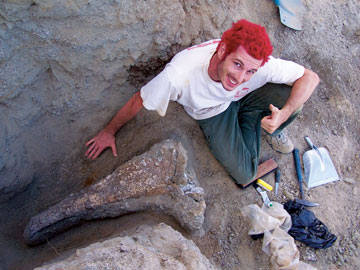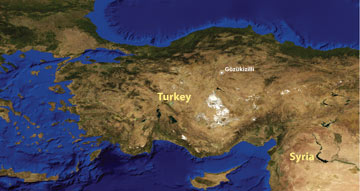|
NEWS NOTES
Rhino fossil bridges land gap
 Copyright Cyrille Delmer 2006 |
| Fossilized rhinos found in Turkey suggest that Anatolia wasn’t separated from Asia. |
 AGI/NASA |
Today the peninsula of Anatolia is firmly attached to Asia, surrounded by the Black Sea to the north, the Aegean Sea to the west and the Mediterranean Sea to the south. But 25 million years ago, it was an archipelago separated from the mainland by the ancient Paratethys Sea — or was it? The recent discovery of a fossilized giant rhino and other extinct mammals in Anatolia is calling into question this long-held assumption.
Researchers thought Anatolia, or Asia Minor, was an archipelago at this time because the peninsula boasts many marine deposits dated to the Oligocene (about 34 million to 24 million years ago). This evidence of seawater, plus the lack of known Oligocene-aged land deposits, led researchers to conclude that Anatolia had been isolated from Europe and Asia until the African and Eurasian plates began colliding about 20 million years ago, says Pierre-Olivier Antoine of the University of Toulouse in France.
In 2002, however, Antoine and his colleagues from France and Turkey began to question this logic after one of them found fossilized rodents in Gözükizilli in north-central Anatolia. Then, on the other side of the same hill, they found a 1.2-meter-long fragment of a fossilized forelimb belonging to a giant rhino, one of the largest terrestrial mammals that ever lived, Antoine says. Although giant rhinos had previously been found throughout Asia and parts of Eastern Europe, this is the first evidence that they lived as far south as Anatolia. “It was both a spectacular and astonishing finding and it forced us to investigate and excavate the surrounding layers,” which led to the discovery of more mammals, he says.
All of the mammals that Antoine and his colleagues have uncovered closely resemble either European or Asian mammals of the Late Oligocene, the researchers reported in March’s Zoological Journal of the Linnean Society. Therefore, at the very least, a land bridge must have connected Anatolia to the mainland to allow for the migration of these animals, they wrote. And it may be that Anatolia was never separated by an ocean.

 Subscribe
Subscribe


